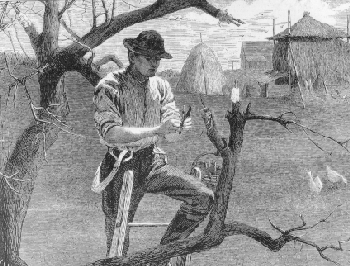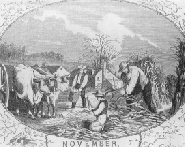 |
Around 1790, the first pioneers of Knox County settled the land along a winding river which the Indians
called Owl Creek. They cleared away heavy timber, erected log houses, and
plowed a few acres to plant grains and corn. Some early settlers,
drawn by new economic opportunities further
west, sold their cleared plots to newcomers, who added fencing and expanded the
fields to create established farmsteads. Farmers often built on an original
log structure to complete a finished house, which became the family homeplace,
passed on through the generations. Before choosing a plot of land to clear and
build a home on, the settlers would look at several wilderness sights or partially
cleared farms. After choosing a plot the pioneer would bargain for the land and then
begin the long process of land clearing. |


 The settlers endured many hardships,
including the Indian wars in 1791-1795, which made clearing
and planting extremely dangerous. Malaria from stagnant water was a major health threat
to the settlers. Wolves often destroyed livestock, while pigeons,
turkeys and squirrels destroyed grain.
The settlers endured many hardships,
including the Indian wars in 1791-1795, which made clearing
and planting extremely dangerous. Malaria from stagnant water was a major health threat
to the settlers. Wolves often destroyed livestock, while pigeons,
turkeys and squirrels destroyed grain.

 E-Mail The Family Farm Project
E-Mail The Family Farm Project